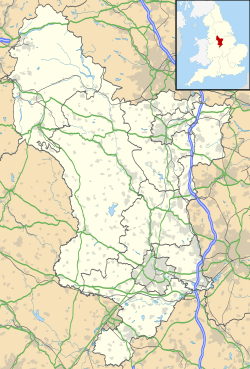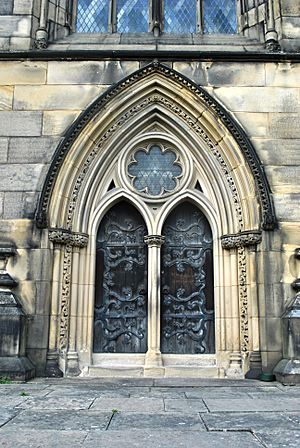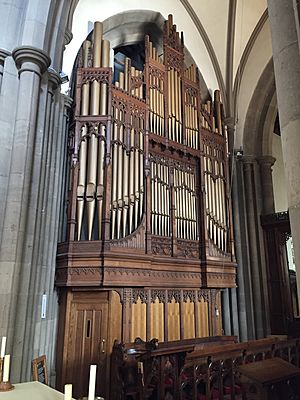All Saints' Church, Bakewell facts for kids
Quick facts for kids All Saints' Church, Bakewell |
|
|---|---|
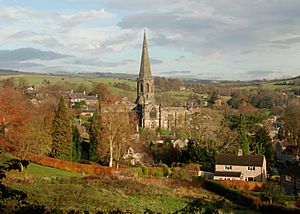
All Saints' Church, Bakewell
|
|
| 53°12′46.44″N 1°40′42.96″W / 53.2129000°N 1.6786000°W | |
| OS grid reference | SK 21556 68483 |
| Location | Bakewell, Derbyshire |
| Country | England |
| Denomination | Church of England |
| Website | bakewellchurch.co.uk |
| History | |
| Founded | 920 |
| Dedication | All Saints |
| Architecture | |
| Heritage designation | Grade I listed |
| Administration | |
| Parish | Bakewell |
| Deanery | Peak |
| Archdeaconry | Derbyshire Peak and Dales |
| Diocese | Derby |
| Province | Canterbury |
All Saints' Church in Bakewell, England, is a very old and important church. It's known as a Grade I listed building, which means it's a special historical place. This church has been a central part of the town for over a thousand years.
Contents
The First Church: A Look Back in Time
The first church here was built way back in 920, during the time of the Anglo-Saxons. If you visit the churchyard, you can still see two ancient crosses from the 9th century! During big repair work in the 1840s, builders found many carved pieces of Anglo-Saxon stone. They also found some old stone coffins hidden in and around the church's entrance.
The Present Church: A Story of Rebuilding
The church you see today started being built in the 12th century. It was in the Norman style, which was popular back then. However, only the front part and some of the main hall (called the nave) are left from that time. Most of the church was built between 1220 and 1240.
A tall, pointy tower called a spire was added in 1340. But it was taken down in 1825 because it was unsafe. The main tower was also removed in 1830. Before these changes, the church was about 55 meters tall to the top of its spire. It was about 46 meters long from east to west and 32 meters wide across its arms (transepts).
Major Repairs and Changes
Between 1841 and 1844, the church was almost completely rebuilt. It had become quite dangerous. This big restoration project was led by William Flockton. After the outside was finished in 1844, they started working on the inside. The church got new seats, and the old Norman pillars in the nave were replaced with newer ones. They even added steam heating! This work was done by Mr. Bath of Haddon, with architects John Grey Weightman and Matthew Ellison Hadfield overseeing it. The church reopened on September 4, 1851.
The chancel, which is the part of the church near the altar, was repaired between 1879 and 1882. This was paid for by Archdeacon Balston, who was the vicar at the time. New features were added, like a screen under the chancel arch and a new marble floor. In the sanctuary, a new decorated screen called a reredos was put in. It had a carving of a scene from Mount Calvary.
A new room called a north vestry was added in 1897–98. It cost about £700 at the time. The architects were Naylor and Sale, and the builders were T. Allsop and Son. This new vestry was officially opened by the Bishop of Southwell on May 15, 1898.
In 1906–07, the roof of the nave was repaired by Charles Hodgson Fowler. He used a large crane to remove the old roof timbers. New oak trees from Oxfordshire were used for the new roof. This repair cost about £445.
Hidden Carvings: Misericords
All Saints' Church has three special carvings from the early 15th century called misericords. These are small ledges on the underside of folding seats in the choir stalls. They were there to provide a little support for monks or clergy during long services. The church also has eighteen newer misericords from the 19th century, added in 1881.
Old Treasures and Memorials

The church is home to many interesting historical items and memorials. These include items from the important Vernon and Manners families. There's also a beautiful 14th-century baptismal font used for baptisms.
In the Vernon Chapel, which is a side chapel, you can find several grand tombs. These include the tomb of Sir Thomas Wensley, who died in a battle in 1403. There are also tombs for John Vernon of Haddon Hall (who died in 1477) and Sir George Vernon and his two wives.
Sir George Vernon, known as 'King of the Peak', died in 1567. He was the father of Dorothy Vernon, who famously ran away to marry John Manners. Both Dorothy and John have a monument at the south end of the chapel. You can also see a monument to their son, George Manners, and his wife Grace.
Outside this chapel, there's a smaller 14th-century monument made of alabaster. It's for Sir Godfrey de Foljambe (who died in 1376) and his wife Avena (who died in 1382). This monument is very rare. It shows Foljambe and his wife as if they are looking out of a window. You can still see this on the south wall. Below the monument, there's an explanation, but this was added much later, in 1803.
Colorful Stained Glass Windows
The church has many beautiful stained glass windows that tell stories and show religious figures.
-
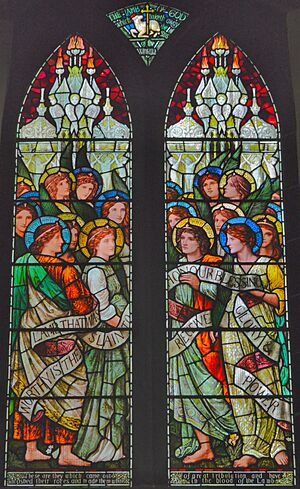 Saints and Angels adoring the Lamb of God by Henry Holiday
Saints and Angels adoring the Lamb of God by Henry Holiday - A window in the north aisle from 1893 by Henry Holiday shows Saints and Angels worshipping the Lamb of God.
- Another north aisle window by Charles Eamer Kempe shows St. George and St. Hubert.
- The chancel's east window dates from 1892.
- A window in the north transept from 1881 was made by Hardman & Co..
- The "Resurrection window" in the Vernon Chapel, from 1859, is also by Hardman & Co..
- The south transept's south window, from 1851, was made by William Wailes.
The Church Organ
The church's organ has a long history. The first "finger organ" was put in back in 1810. It was rebuilt several times over the years, in 1851, 1859, and 1883. More work was done in 1954 and 1989. Today, the church has a large pipe organ with three keyboards and 42 different sounds. You can find more details about this organ on the British Institute of Organ Studies website.
All Saints' Church Today
Today, All Saints' Church is still a very active place. It holds regular church services and is an important building for the town of Bakewell and the wider Peak District area. It's used for concerts by the Bakewell Choral Society. It also hosts the annual service for Lady Manners School, where staff and students give thanks to Grace, Lady Manners, who founded their school in 1636.
You can visit the church website to learn more about what's happening at the church, including upcoming services and events.
Connected Churches
All Saints' Church is part of a group of churches in the area. It shares a parish with:
- Holy Trinity Church, Ashford-in-the-Water
- St Anne's Church, Over Haddon
- St Katherine's Church, Rowsley
- St Michael and All Angels' Church, Sheldon
See also
- Grade I listed churches in Derbyshire
- Listed buildings in Bakewell
Images for kids


